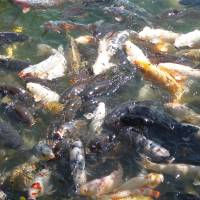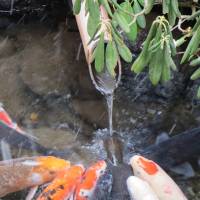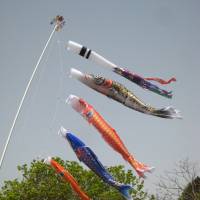While shuffling back from my early-morning dip in a hot spring at Kambayashi Onsen, I noticed the fish in the garden pond. They had gathered, heads together, in a strange starlike cluster, as if for a piscine tête-à-tête. They were languorously wafting their tails slowly through the water as if barely alive.
All around, the snow was deep; winter had not yet withdrawn, and the air was filled with falling flakes. Less than 2 km away were the famous snow monkeys of Nagano Prefecture at Yaen-Koen, but here I was watching fish at dawn. Slow-witted from my outdoor soak, I wondered idly how the carp tolerated cold mountain water. I watched them for a while, thinking my own fishy thoughts, when I noticed the pipe. A length of tan-brown bamboo protruded from the moss and rhododendrons overhanging the pool. The pipe's tip, cut at an angle, allowed a trickle of water to flow and drip into the pool, and it was beneath this inflow that the carp had gathered.
As I watched this parliament of fish, the individuals shifted and moved slowly. It was as if they were jousting and jostling in slow motion for a central position where each settled for a while with the miniature cascade pouring onto its head. As I watched them in their slow gyrations, I was reminded of the rotenburo (outdoor bath) from which I was just returning and how, with the pool being somewhat tepid that morning, I had taken refuge in the water beneath the inflow, huddling ever closer for its warmth. Were these fish doing the same? Later, when I investigated, I found that indeed the fish were warming their brains, by swimming beneath an inflow that was at a very comfortable 40 degrees Celsius!
For many years I have made an annual pilgrimage to Nagano's Jigokudani to spend time with the local Japanese macaques, observing them also in their hot spring at Yaen-Koen. On one occasion I even had one of those monkeys join me for an early-morning bath in the outdoor hot spring just across the Yokoyu River from Yaen Koen, at the Korakukan inn. Despite years of watching, and during countless hours spent in hot springs, and though I even keep a list of the many species of birds and mammals I have observed while soaking in therapeutic hot waters, I have only seen one other species soaking in a hot spring, and that is the Japanese macaque — until now! Now I have seen nishikigoi in their very own hot spring.
The gorgeous colors of Japanese brocaded carp are achieved through selective breeding. Left to their own devices within a few generations their offspring return to their naturally drab crypsis of dull olive scales. In the dark water in the dull light of morning, I had mistaken one of those naturally colored fish for a rounded rock set beneath the inflow — until it moved.
That sight triggered a "hemory" (half memory, perhaps half imagination) of a vaguely similar scene of a rock beneath a waterfall. Then it came to me where I had seen it — at Kinkakuji in Kyoto. There, a particular rock is said to represent a carp swimming upstream and seems to echo a late Han Dynasty myth that says that if the carp succeeds in climbing the rapids of China's Yellow River, it will become a dragon. The Japanese saying "koi no taki-nobori" ("koi climbing the rapids") reflects this too, in the belief that the carp is a spirited fish, so strong that it can fight its way up waterfalls, and through its strength and determination overcome all obstacles. The carp, evoking images of energy, power and courage, is a worthy symbol for overcoming life's difficulties and achieving ultimate success.
Fluttering flags in the shape of carp abound here in spring, in early celebration of the coming of May 5. Koi-nobori, known globally now as carp streamers, fill with wind and seem to swim in the air, setting off for success. Now Kodomo no Hi (Children's Day) but previously Tango no Sekku (Boys' Festival), one of the most popular national holidays, is celebrated in Japan by flying a carp streamer for each child (previously only for sons), a very large one for the eldest, the others ranging down in size, all hoisted on a tall bamboo pole crowned with a pair of spinning pinwheels. There can hardly be a more potent symbol for sending off one's children into the wide world to achieve success through determination.
The Bavarian physician-botanist Philipp Franz von Siebold (1796-1866), in his "Fauna Japonica" series of monographs (1833-1850), described three species of carp from Japan, but the ornamental brocaded carp that we know today consists of varieties derived from the domesticated common carp, a hardy cold-water fish bred specifically to decorate ponds and water gardens. Their patterns are widely variable, as are their colors, with black, red, orange, cream and white being predominant. Where China developed the goldfish from the Prussian carp, Japan developed nishikigoi from common carp, and the two are readily distinguished because koi have distinctive barbels (fleshy wattles dangling from their lips) that goldfish lack. Whereas koi have a more standard body and fin shape, but a wide range of colors and patterns, goldfish have widely varying body, fin and tail shapes. Koi values vary enormously, too, with some fish rumored on the Internet to be valued at over ¥25 million.
The bright colors of nishikigoi render them distinctive even at a distance, though it is rare and unusual indeed to see one at long range! However, once while I was in Himeji, I looked up and saw an Osprey flying overhead carrying its catch.
This wide-ranging fish-eating bird of prey has a unique and distinctive way of catching its quarry by plunge-diving into water feet-first. The Osprey then takes off, clasping its prey in one or both feet. As it settles into flight back toward a suitable perch or to its nest, it transfers its catch using its rough-scaled feet and needle-sharp claws into a head forward, tail back position so that the fish resembles a torpedo slung beneath an aircraft.
On that particular occasion, the "torpedo" beneath the Osprey was a bright orange-red, and through binoculars I could make out that the bird was carrying a brightly patterned nishikigoi. It was perhaps the most valuable meal caught by any Osprey in the world. That particular nishikigoi had tackled the waterfall, but was destined to return as a voracious Osprey, not as a dragon.
Mark Brazil has written Wild Watch for more than 30 years. He also organizes and leads wildlife, birding and photographic excursions around Japan. His latest book, "The Nature of Japan: From Dancing Cranes to Flying Fish," is available from www.japannatureguides.com or from the Junkudo Ikebukuro bookshop in Tokyo.





















With your current subscription plan you can comment on stories. However, before writing your first comment, please create a display name in the Profile section of your subscriber account page.